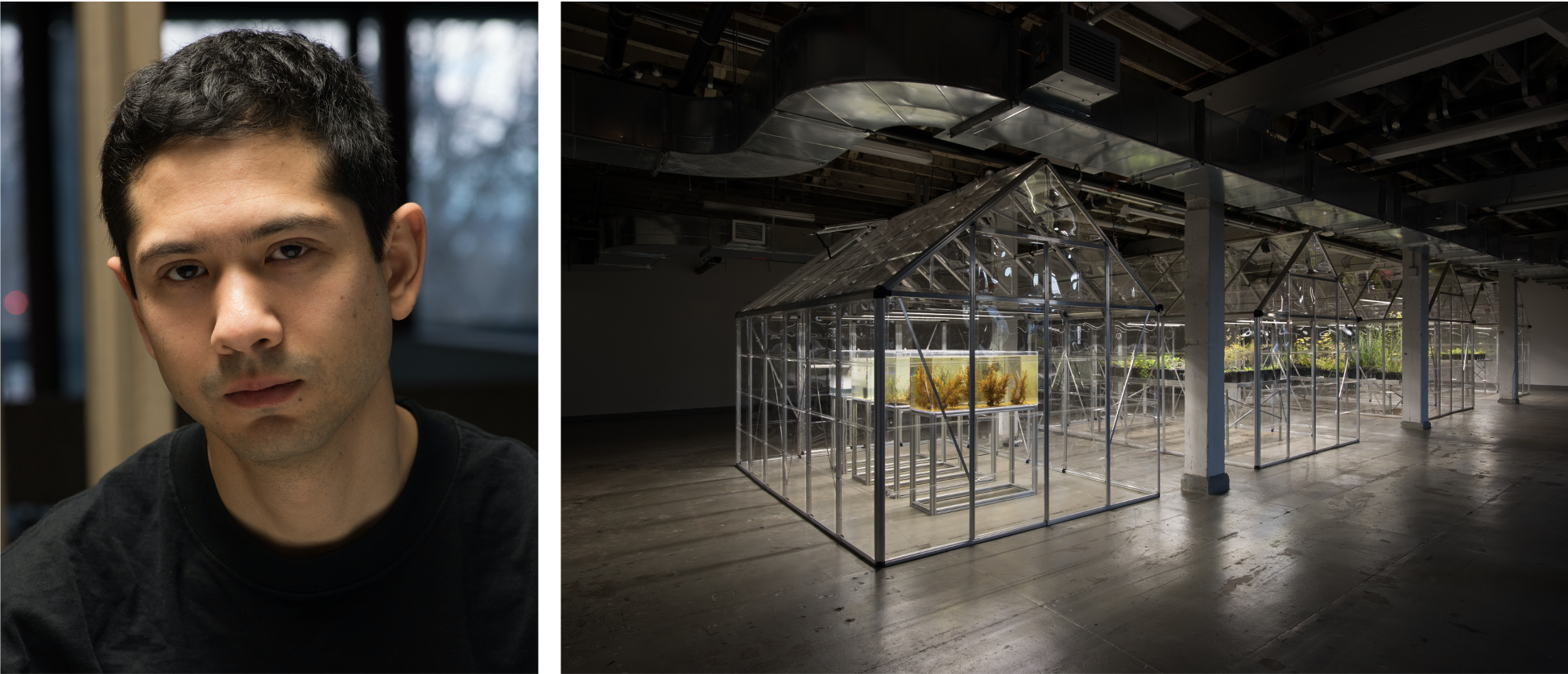Art of Change 21 – How did you start to deal with environmental issues in your work?
I have always been drawn to the natural world. My father is a geophysicist, and some of my first memories are of the small museum of geology in the building where he worked. At its entrance was an enormous, revolving globe. Perhaps this image can be linked to my later interest in working at a planetary scale.
My artistic practice is influenced by Institutional Critique and Land Art: Hans Haacke and Nancy Holt and Robert Smithson. I studied architecture and I was initially drawn to architecture’s status in between art and the “real” world. As an artist, I still hope to create an art with broader effects.
AOC 21 – Extinct in the Wild is your major project based on the real scientific list of the same name, published by the IUCN (International Union for Conservation of Nature). Tell us more…
The relationship between nature and culture is at the core of my work, and the EW “Extinct in the Wild” list published by the IUCN relies on a strong separation between the two. I was drawn to this category precisely because it allowed me to focus on this divide between the natural and the artificial, what is “wild” and what is not.
Extinct in the Wild focuses on flora and fauna which can no longer be found in nature, but persist exclusively in cultivation or captivity. The list of species that fall under this category is constantly changing. New species are added and others, sometimes, are removed. These changes reflect how much we humans influence ecological systems. For the Extinct in the Wild exhibitions, I bring a selection of living organisms considered extinct in nature into spaces of art. Each species is displayed within a life-support system tailored to the unique needs of the organism. Exhibition staff are trained to become caretakers. These species now cannot survive without maintenance by people and technology. Instead of purely natural beings, that are, in some sense, transformed into products of culture, whether horticulture, scientific research, or the pet trade.
For the related work Extinct in New York, I exhibited plant, algae, and lichen species that are known historically from New York City but are no longer found growing wild in the city. I spent a year growing around fifty of these species in my studio garden before temporarily exhibiting these on Governor’s Island in New York. After the exhibition, the plants were distributed to city parks. They were returned to the city, but they persist now only under the care and supervision of gardeners.
This work is part of a dream for a new kind of city: a city built not only for humans, but also for other species, including, even, those that the city originally displaced through urban growth, changes to water chemistry, wetland drainage and climate change. How can we cohabitate? My goal is to promote diversity in all its specificity and multiply interspecies relationships through practices of care.

Credit: Michael Wang, Carbon Copies, courtesy of the artist, 2012 / Michael Wang, Drowned World First Forest, courtesy of the artist, 2018
AOC 21 – What is the next extinct species you will explore?
The Carolina parakeet! A species of small green parrot that was native to the United States but which has not been seen since the 1930s. I am exploring the way in which this bird, which no longer lives in nature, continues to live in American culture. Most recently, this extinct bird was even included in a blockbuster video game, Red Dead Redemption 2. Terrence Malick created a computer-generated Carolina parakeet for his 2005 film The New World. The parrot, a symbol of mimesis, becomes the subject of myriad mimetic representations.
AOC 21 – In The Drowned World, which was a highlight of Manifesta in Palermo in 2018, you presented plants in order to talk about fossil fuels…
Yes, I wanted to explore the ancient origin of fossil fuels, to reveal the hidden organic origins of the modern world. Photosynthesis is at the origin of virtually all fossil fuels, and yet people tend to ignore this vegetal inheritance. Most of the world’s coal reserves were formed from the fossilized remains of some of the very first forests on earth: the 300 million-year-old Carboniferous swamps.
For the installation in Palermo I re-created a living “Carboniferous” forest at the site of an abandoned coal gas plant. I selected plant species related to these ancient plant species: tree ferns, cycads, araucarias. These are all plants that arose before the evolution of flowers. I installed this forest — from small ground dwelling ferns to 10 meter trees — between the decaying gasometers. The living origins of coal returned to colonize the very site where coal was vaporized to form fuel. In 2020, I returned to the drone footage I had made of the installation and incorporated this into a short film that tells the story of earth’s climate and imagines a possible future in which climate change in effect “restores” the warmer climate of the early Carboniferous period.
AOC 21 – About 10 years ago, you had a project to offset the carbon emissions released in the production of contemporary artworks, and Damien Hirst and Jeff Koons were on the list!
This was a project called Carbon Copies. I calculated the carbon emissions of highly visible artworks and then made small models (“Carbon Copies”), mostly of paper, that reflected the scale of each work’s footprint. The price of each Carbon Copy was the exact dollar amount required to remove this quantity of carbon dioxide released by the original artwork through the purchase of certified carbon offsets. The goal was not purely moralistic, although the work was often read in these terms. I am aware that nearly every human action results in carbon expenditure. Carbon is wrapped up in creation. I wanted to show that, in a sense, all artworks are already a kind of “land art” (or “air art”) although this is generally unacknowledged. Each work exists, in shadow form, as an invisible intervention in the earth’s atmosphere–as CO2.
At the same time, I think that artists and all art workers, owners, and institutions should be aware of their environmental impacts. In my work with living plants and, more rarely, animals, I must make many decisions with ethical implications. Many of my exhibitions are temporary, and I need to think of the afterlife of the work—to provide new contexts for living beings and new life for non-living materials.
AOC 21 – What’s new in terms of the pandemic?
Beyond social and economic crises, there are deep cultural changes. The crisis of the pandemic has also brought greater awareness to the global intra- and interspecies entanglements within which we live. We realize that we humans are not apart from, but inextricably bound up with, the natural world. We are linked to bats and viruses, and these relationships are dynamic and interactive. In this context, thinkers who have been important to my own work, such as Donna Haraway or Anna Tsing, are finding ever wider audiences. Entanglement and interconnectivity between species resonate with lived experience.
AOC 21 – How would you define your role as an artist if an artist must have one?
Ecological issues can be difficult to comprehend because they are either too macro or too micro. To me, artists can play a role in making these ecological issues more felt and more visible. I believe a very narrow conception of what constitutes environmental art (from an “art world” perspective) is broadening. Ecological art cannot be a “niche” because an environmental practice is necessarily connected to all other forms of activist art.
AOC 21 – What are your next projects?
My hope is to go to Shanghai to take part in the Shanghai Biennale, which is scheduled to open in April. I am ready for a three-week long quarantine. I am creating a work that focuses on the ecological, cultural and technological dimensions of the Yangtze river. In this work, I am recreating a fragment of the glacier that forms the river’s origin—displaced to Shanghai, at the river’s terminus. The work, which requires refrigeration units, will be powered by the Shanghai grid, which draws energy from the Three Gorges Dam, the major dam on the Yangtze which is in fact the world’s largest power station. So the river in a sense powers its own representation.
Similar to The Drowned World, this work puts the origin of modern energy on display and connects it to its natural origins. Coal is a threatened resource: 300 million years of coal are being used up in just a few hundred years. Similarly, the glaciers at the origin of the Yangtze, too, are threatened. Climate change is shrinking these Himalayan glaciers, in a region sometimes known as the earth’s “Third Pole”.
In 2021, Extinct in the Wild will also be exhibited in a contemporary art exhibition organized by Art of Change 21* at the next IUCN Congress in Marseille.
Alice Audouin
February 2021
Credit: Michael Wang headshot, courtesy of the artist, 2020 / Michael Wang, Extinct in New York, courtesy of the artist, 2013
Find the Impact Art News n°27 – February 2021
To subscribe to Impact Art News (free): here

